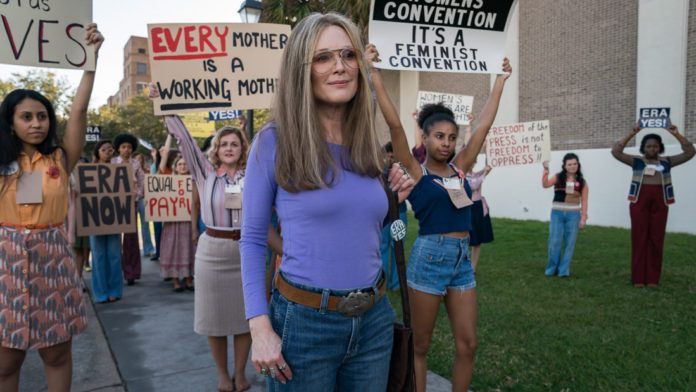Gloria Steinem is a figurehead for feminism worldwide. But in Julie Taymor’s The Glorias (2020), we see her as more than that: a vulnerable woman with thoughts, feelings, dreams and pain.
When people picture Steinem, they often immediately think of her ionic aviator shades and trademark middle-parted long hair, the exposé on Playboy she wrote in 1963, or the women’s magazine (Ms. magazine) she helped to create. We don’t often think of her as the naïve child she once was or the teenager with the whole world on her shoulders.
Taymor’s film, based on Steinem’s 2015 autobiography, My Life on the Road, tells Steinem’s whole story. The film, featuring a majority female production team, was released at Sundance Film Festival on Jan. 26. It was made available to stream on Amazon Prime and Apple TV on Sept. 30.
The Glorias dives into the financial troubles Steinem’s family faced in the 1930s and 40s, and the early beginning of her ‘life on the road.’
“Travel is the best education,” says Leo Steinem (Gloria’s father, portrayed by Timothy Hutton) in the film. “In fact, it’s the only education.”
Steinem’s story is so lengthy that she is portrayed by four actresses throughout the film. As a child, she is played by Ryan Kiera Armstrong, then Lulu Wilson as an early teen. Next, as a young woman and budding journalist, Alicia Vikander takes over the role.
When Julianne Moore steps into the role, Steinem is a mature woman experiencing backlash from the media, reluctantly becoming the face of the feminist movement, and being forced to constantly defend the choices she’s made throughout her life.
From her nomadic beginnings to her secure place at the forefront of the second-wave feminist movement of the 1960s and 70s, The Glorias switches between excerpts and anecdotes from various points in her life, and conversations between Gloria and past versions of herself.

And what a life she’s had! The Glorias captures the peaks and valleys of Steinem’s life in a dynamic and compelling way.
Difficult topics including abortion, death, mental illness, racism and sexism are handled tastefully, yet do not shy away from saying what needs to be said. The Glorias accurately captures the intersectional nature of feminism.
The triumphant moments in Steinem’s life—the formation of Ms. magazine, her work with The New York Times, the publishing of A Bunny’s Tale, her travels to India and learning how to stand up for herself against the patriarchy—are downright inspiring.
The soundtrack of this movie is subtle yet creates such an immersive feeling so that the viewer can completely empathize with Steinem at any point.
Along with the subtly powerful music, the film utilizes many complex visual sequences using animation, voiceover, and special effects. While aesthetically pleasing and thought-provoking, these elements detract from the scenes rather than add. Many of these sequences create a dreamlike quality that feels out of place and counterintuitive to the onscreen narrative.
Regardless, at its core, The Glorias tells a story that deserves to be told. And this story is told in an inimitable and intricate way. Watching such a powerful woman’s story told in a climactic order, and featuring her own personal reflection throughout helps us to understand and relate to the icon.
The film demystifies her and helps us to find a part of ourselves in Gloria Steinem; whether it be struggling with public speaking, dealing with significant loss, feeling underappreciated, or dealing with imposter syndrome. The conversation she has with herself includes us too.
I found the ending of the movie to be the most emotional. I was moved to tears multiple times. The whole time you think it’s called The Glorias because there are multiple portrayals of Gloria.
At the very end of the film, Steinem herself makes an appearance, and we see her speak at the 2016 Women’s March. Then, the camera pans out to a whole sea of women and the title appears. And I realized every woman who fights this fight is a ‘Gloria’ because Steinem’s struggles are all too common. Steinem never wanted to be the sole face of the feminist movement.
I like to think she would want every feminist to know that they are the face of their own movement, and it is all of these individual stories that make feminism work.
I would highly recommend watching The Glorias. It captures many important feminist stories and helps inspire us to tell our own.






